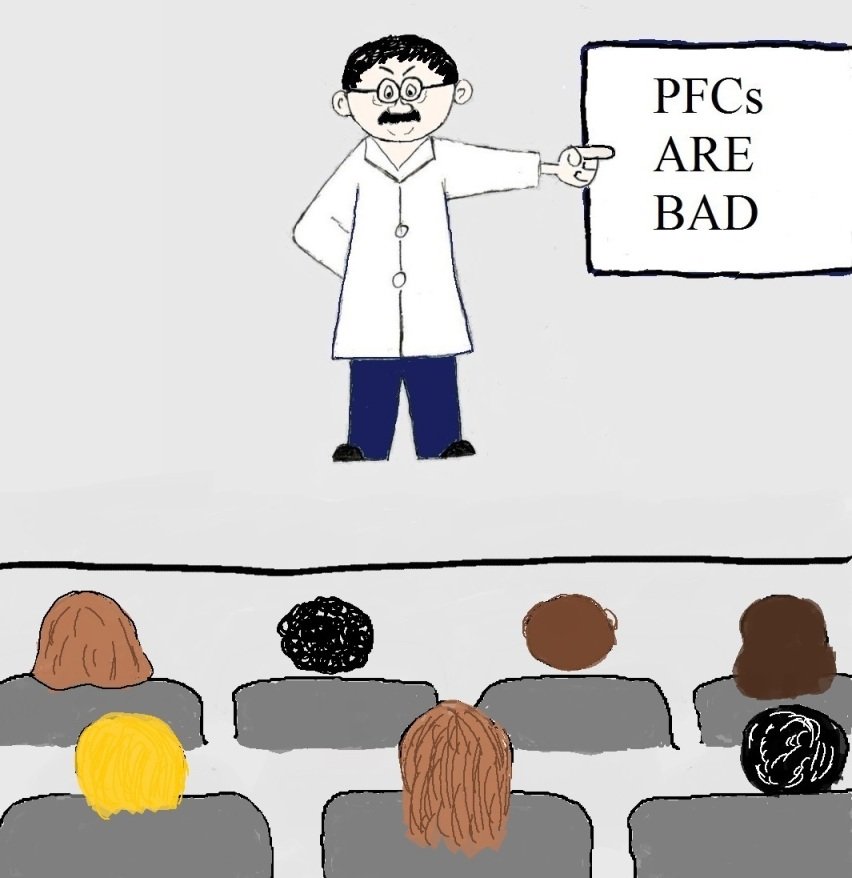- Home
- Toxic Chemicals & Health
- Toxic Forever Chemicals
Toxic Forever Chemicals - PFAS
PFAS are called "The Toxic Forever Chemicals" because they don't degrade easily. So they persist in the environment and in you.
This group of different man-made chemicals contain carbon, fluorine, and other elements. And there are nearly 5,000 types of PFAS, some of which have been more widely used and studied than others.
What Are Toxic Forever Chemicals?
PFAS stands for Per- and polyfluoroalkyl substances. They are a class of chemicals used to make things stain and stick resistant. PFAS's are molecules made up of carbon chains to which fluorine atoms are bound. Fluorine adds the slippery quality.
Because these man-made chemicals resist heat, water and oil, they are in products like food packaging, stain- and water-repellent fabrics, nonstick products, polishes, waxes, paints and cleaning products. Oil of Olay even includes it in some of their wrinkle creams!
Due to contamination from industries and military bases, drinking water is also an important source of exposure. In fact, drinking water now rivals food as a source of exposure to PFAS's, like PFOA and PFOS.
And because they're made to be resistant, it means that this group of toxic chemicals don't break down easily. So, they last forever, in the environment and in you.
Types of Toxic Forever Chemicals
The two most common forms of toxic forever chemicals are:
- PFOS (perfluorooctane sulfonate), used for stain resistance in products like Scotchgard. It has been replaced, but there is no information available on the new Scotchguard formula.
- PFOA (perfluorooctanoic acid) is used to make products nonstick, like Teflon (PFTE).
PFOA and PFOS aren't made in the US anymore. But, they are still produced internationally and can be imported in things like carpet, leather and apparel, textiles, paper and packaging, coatings, rubber and plastics.
And, because they are persistent organic pollutants that takes many years to break down, PFASs will continually circulate through our bodies, the environment and the food chain.
Also, the chemicals that are replacing PFOA and PFOS can be just as toxic to your health. For example, PFOA has been replaced by PFBS, a sister to PFOA, which probably breaks down into PFOA.
In other words, the newer short-chain versions of PFASs that are replacing the older long-chained ones, are also hazardous to your health.
Plus, there are many other PFASs, including GenX chemicals and PFBS, that are proving to be toxic to your health.
According to the EPA "GenX is a trade name for a technology that is used to make high performance fluoropolymers (e.g., some nonstick coatings) without the use of perfluorooctanoic acid (PFOA)".
How You're Exposed
You're exposed to toxic forever chemicals when you wear stain-resistant, water-repellent and wrinkle-free clothing and sit on furniture and carpeting that was treated with PFAS.
Stain-resistant carpeting and furniture can also contaminate your indoor air with PFAS just like cooking with nonstick pans. Food packaging (microwave popcorn, pizza boxes, fast food containers) is also a source of exposure.
PFASs are also used as surfactants (substance that reduces the surface tension of liquids so that the liquid spreads out, rather than collecting in droplets) in shampoo, dental floss and denture cleaners. Plus, they are used in making some types of plastic.
You are exposed to toxic forever chemicals by:
- Eating food contaminated from packaging and cooking in non-stick cookware
- Breathing in fumes when using nonstick cooking and bakeware
- Eating fast food and microwave popcorn
- Drinking water contaminated with them
- Wearing and sleeping on stain-resistant and wrinkle-free clothing and bedding.
- Sitting on stain-resistant furniture and carpets
- Eating high fat foods (because it's stored in fat and moves up the food chain)
- Using cosmetics and personal care products that contain them
- House Dust
Toxic Dust Bunnies
PFASs like PFOA, PFOS, PFBA, and PFBS are volatile organic compounds (VOCs). That means they easily evaporate into the air in your home from carpets, cookware and any other products that contain them. And they can also condense and attach to house dust and surfaces in your home.
To Reduce the amount of toxic dust in your home stop using products with PFAS and dust and vacuum often. But do it right.
Trap it, don’t spread it – The best way to catch a bunny is with a trap. And you won’t do that with a dry dust cloth. Instead, dust with a damp microfiber cloth. And if you have wood floors clean them with a damp mop.
And use a vacuum with a HEPA filter to capture the smallest particles. There are also hepa vacs for furniture and beds.
Health Effects From Exposure
Because PFAS's are toxic forever chemicals, they stay in your body for long periods of time. This is bad because the longer toxic chemicals are stored in your body, the more they can damage your health.
The most commonly studied PFAS's, PFOA and PFOS, can cause reproductive and developmental, liver and kidney, and immunological effects in laboratory animals. And, both chemicals have caused tumors in animal studies.
Human studies have reported that exposure to these toxic chemicals can increase cholesterol levels, affect infant birth weights and your immune system and cause cancer (for PFOA), and thyroid hormone disruption (for PFOS).
Health problems specifically linked to PFAS
- Doubling miscarriage risk in women with higher amounts of PFAS over those with lower amounts
- Significant increase in preeclampsia (a condition causing dangerous hypertension in pregnant women)
- Lower birth weight in babies
- Increased risk of liver, kidney and testicular cancer (higher PFOS levels were associated with a 4.5 times higher risk of liver cancer)
- A reduction in some aspects of the immune response • Nonalcoholic fatty liver disease associated with exposure to PFAS
- Increased cholesterol levels
- Increased thyroid disease
- Increased risk of asthma
- Lowered vitamin D levels
- Increased risk of diabetes
- Increased risk of hypertension in women
- Decreased vaccine response and immunotoxicity
- Also have been found to accumulate in the lungs

